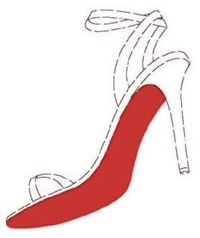The Court of Justice of the European Union (CJEU) ruled that a mark (or "sign," in EU parlance) consisting of a color applied to the sole of a high-heeled shoe does not consist exclusively of a "shape" within the meaning of Article 3(1)(e)(iii) of Directive 2008/95/EC (Directive). Christian Louboutin and Christian Louboutin SAS v. Van Haren Schoenen BV, Case No. C-163/16 (CJEU, June 12, 2018).
In 2013, Christian Louboutin and his eponymous French company sued Van Haren Schoenen BV, which sold high-heeled shoes with red soles in the Netherlands, for infringement of Christian Louboutin's Benelux trademark. This Benelux trademark represents a high-heeled shoe with a red sole and is described as follows: "the mark consists of the color red (Pantone 18-1663TP) applied to the sole of a shoe as shown (the contour of the shoe is not part of the trademark but is intended to show the positioning of the mark)."

Van Haren Schoenen argued that the trademark was invalid on the basis of Article 2.1 of the Benelux Convention (corresponding to Article 3(1)(e)(iii) of the Directive), according to which marks consisting exclusively of a shape that gives substantial value to the goods cannot be considered as trademarks.
The Dutch courts stayed the proceedings and asked the CJEU to consider whether the notion of "shape," within the meaning of Article 3(1)(e)(iii) of the Directive, is limited to the three-dimensional properties of the goods (such as the contours, measurements and volume), and does not include other (non-three-dimensional) properties of the goods, such as their color.
After noting that a color per se may not constitute a "shape," the CJEU considered whether a particular color applied to a specific part of the product results in a protectable "shape." The CJEU determined that a mark consisting of a color applied to the sole of a high-heeled shoe does not consist of a shape since (1) it is not the shape that the trademark seeks to protect, and (2) the mark does not relate to a specific shape of a sole for high-heeled shoes. Additionally, the CJEU found that the mark in issue cannot be regarded as consisting "exclusively" of a shape, since the main element of the mark is a specific color.
This decision clarifies that arguments under Article 3(1)(e)(iii) of the Directive, related to marks consisting exclusively of a shape, can no longer be used within European Union to claim invalidity of the Louboutin red sole trademark.
Practice Note: This decision is positive for Christian Louboutin, who actively sues third parties around the world selling high-heeled shoes with red soles. However, Article 3(1)(e)(iii) of the Directive has been replaced by new Article 4(1)(e)(iii) of Directive 2015/2436 of December 16, 2015, which must be implemented by Member States by January 14, 2019. Pursuant to this new article, "signs [i.e., marks] which consist exclusively of: [. . .] the shape, or another characteristic, which gives substantial value to the goods" shall not be registered or shall be declared invalid. Thus new questions arise: shall a color be considered as "another characteristic," and, if so, will the well-known Louboutin red sole be found to give substantial value to high-heeled shoes? To be continued.
The Louboutin Saga: Victory, For Now
The content of this article is intended to provide a general guide to the subject matter. Specialist advice should be sought about your specific circumstances.

